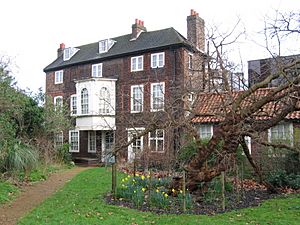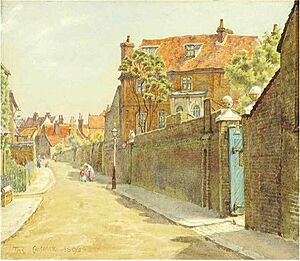Hogarth's House facts for kids
Quick facts for kids Hogarth's House |
|
|---|---|

Hogarth's House. The mulberry tree in front was there when Hogarth lived in the house.
|
|
| Location | Chiswick |
| OS grid reference | TQ 21250 77891 |
| Area | London Borough of Hounslow |
| Built | 1713 - 1717 |
| Owner | London Borough of Hounslow |
|
Listed Building – Grade I
|
|
| Official name: Hogarths House, Wall and Gate of Hogarths House | |
| Designated | 11 June 1951 |
| Reference no. | 1358340 |
| Lua error in Module:Location_map at line 420: attempt to index field 'wikibase' (a nil value). | |
Hogarth's House was the countryside home of the famous 18th-century English artist William Hogarth. It is located in Chiswick, which is now a part of west London. When Hogarth lived there, Chiswick was a small town separate from the big city.
Today, the house is a historic house museum owned by the London Borough of Hounslow. You can visit it for free to see where the artist lived and worked. Because of its historical importance, it is a Grade I listed building, which means it is protected by law.
Contents
History of the House
Early Owners
The house was built between 1713 and 1717 in an orchard. Its first resident was a pastor named Rev George Andreas Ruperti. He used it as his home in the country, away from the busy city of London.
After the pastor died, his family kept the house for a while. William Hogarth and his wife bought it from the pastor's son in 1749.
The Hogarth Family Home
The Hogarths loved their country home. They made it bigger in 1750. It was a peaceful place for the artist to relax and work. He even had a special "painting room" built over the coach-house at the end of the garden.
Hogarth lived there with his wife, his mother-in-law, his wife's cousin Mary Lewis, and his sister. Mary Lewis helped him run his art business.
William Hogarth died in 1764 and is buried in a nearby churchyard. His friend, the famous actor David Garrick, wrote the tribute on his tomb. The family continued to live in the house until Mary Lewis died in 1808.
Life After the Hogarths
From 1814 to 1833, the house was owned by Rev Henry Francis Cary. He was a poet and a well-known translator of Dante's famous work, the Divine Comedy. After Cary, the Wickstead family bought the house in 1833. They later moved to Australia and rented the house to other people.
Becoming a Museum
By the late 1800s, the house was in poor condition. In 1890, a man named Alfred Dawson, who lived next door, saved the house. He repaired it and leased it to a gardener.
In 1901, the house was put up for sale to be torn down. A group of artists and writers tried to save it but couldn't raise enough money. Luckily, Lieutenant-Colonel Robert William Shipway bought the house. He carefully restored it and filled it with copies of Hogarth's art and furniture. He opened it as a museum for the public in 1904. In 1909, he gave the house to the local government to care for it.
The house was damaged by a bomb during World War II in 1940. It was repaired and reopened in 1951. In 1997, the inside of the house was updated to celebrate 300 years since Hogarth's birth.
To mark the 250th anniversary of Hogarth's death in 2014, the museum held a special art show. It featured works by famous artists and celebrities like Quentin Blake and Peter Blake, who were inspired by Hogarth.
Major Restoration Project
The house closed in 2008 for a big refurbishment.
Fire and Repair
Sadly, a fire broke out in the empty house on August 14, 2009. No art or furniture was lost, but the fire badly damaged the staircase and one room. The rest of the house had damage from smoke and water.
The entire building was carefully restored. Experts studied the house's history to make sure the repairs were accurate. They even analyzed old paint to use the right colours. During the repairs, they uncovered original features like window shutters and fireplaces.
Re-opening to the Public
The museum officially re-opened on November 8, 2011. Today, visitors can explore two floors of the house. The displays show what it was like as a family home and celebrate Hogarth's amazing life and work.
You can see prints of some of his most famous art series, like A Rake's Progress and Marriage à-la-mode. These series tell stories through pictures, much like a modern comic book.
The house also has a beautiful walled garden. In the garden is a special mulberry tree that is very old. It was probably part of the original orchard from the 1670s. The tree was damaged in the World War II bombing but was saved by tree experts from Kew Gardens.
See also
- List of single-artist museums


